The following is an account by Jamie Sharp of an eleven-day trip down the Colorado River he undertook with Jillian Brown, kayaking the Grand Canyon together in a tandem sea kayak.
We were standing next to our kayak on the bank of the Colorado River in the depths of the Grand Canyon, its rusty red rocks towering above us. Downstream lays a tricky and impressive rapid called Hance. We have just returned from scouting the line and we’re rethinking our moves.
“Are you nervous?”
Jill looked up at me with a wry smile. “No, ” she stated flatly. “We’ve got this. We’ve made it this far and hey… I trust you.”
I smile as Jill climbs into the bow seat of our yellow 22-foot double sea kayak. Once her gaze is off me, my smile contorts into a bemused grimace and I push the bow away from the shore into the deceivingly tranquil muddy waters above the chaos downstream. I climb into the rear seat and find myself chuckling under my breath. I am bemused at her statement, what does trust have to do with not feeling fear?
Forward we go!
I call “forward paddle” and in unison we paddle our large oceangoing craft out of the eddy into the downstream flow to face the coming rapid. As we drop over the lip into the cauldron of standing waves and foaming recirculating holes stretching out ahead for 200 meters or so, I find myself thinking “Hell! It doesn’t matter how much she trusts me. This is crazy.”
Perhaps it was because Jill doesn’t know any better. Maybe she doesn’t fear these rapids because she isn’t making the calls, or perhaps she is just being brave. Either way, what makes me scared is what I know and she doesn’t. I know these rapids hold the power to crush our fiberglass sea kayak if we make a wrong decision.
I know steering a double sea kayak fully loaded with 11 days food and gear through some of the largest rapids in North America is actually quite tricky.
Then to top it off, I am doing the trip with someone who doesn’t know how to roll and has never paddled a large river like this before. The responsibility of not screwing up makes me plenty nervous. But hey, it was my big idea in the first place.
Back to old stomping grounds
This trip is my third journey down the Grand Canyon. This time I wanted to bring my girlfriend with me. The tricky part is to do the whole trip without raft support, and my girlfriend at the time was not a kayaker. And so began the planning of how to get her down the canyon without a raft.
I have paddled a single sea kayak down the 20-day run as well as oared a raft through the Canyon. I knew what to expect and decided a double sea kayak could be a feasible idea.
In the spring I came across a great deal on what I had decided was the perfect craft. I picked up a used Seaward Passat G3 double. This particular design is agile, with an up-swept bow for punching through surf, or in this case, driving through whitewater. It could carry a lot of gear and had very good hull speed. Now all that was left was some pre-trip training.
A big problem with double sea kayaks is the almost inevitable power struggle that occurs, especially between couples. For this reason doubles are commonly nicknamed, divorce boats. I personally have always enjoyed journeying in double sea kayaks.
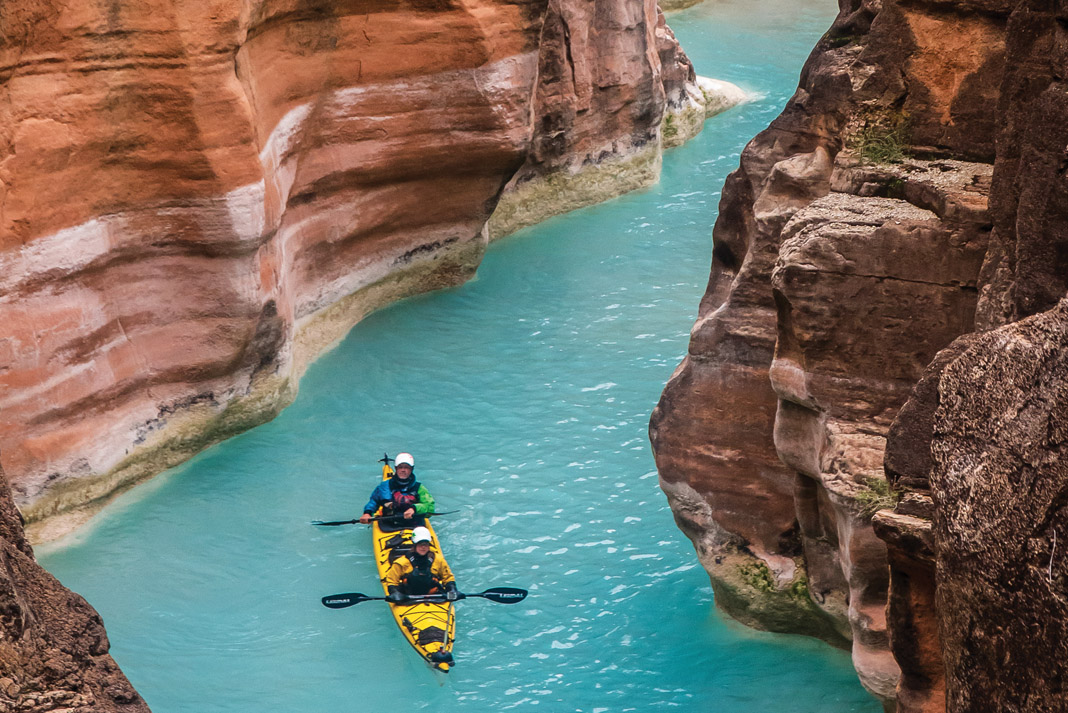
The extra efficiency and safety makes them a great long distance touring vessel, especially with an inexperienced team member. Which is why the Passat G3 is so popular with sea kayaking outfitters and tour companies.
During the training lead up, I used the double in a surf competition in Washington State where it managed to help seal a second place podium position in the open category. The surf competition confirmed the agility and good design of the kayak, though ironically perhaps, the double lived up to its nickname. I had gone through two relationships on my way to kayaking the Grand Canyon.
Two weeks out from our launch date, I found myself in desperate need of a paddling partner to tackle this crazy journey.
My friend and outdoor photographer Jillian Brown jumped on the chance despite not being a whitewater kayaker, not having a roll and not having time to practice before hitting the river. I think the adventurer in both of us kind of liked these odds.
Exploring the Colorado River
With 30,000 people going down the Grand Canyon each year, paddling a tandem sea kayak added a touch of unknown to the trip, something like Powell’s first descent down the Colorado back in 1869.
John Wesley Powell led, what is believed to be, the first voyage of white men through the entirety of the Grand Canyon. The voyage, conducted in shallow draft wooden dories, started on the Green River and ended at the end of the Grand Canyon at the confluence of the Virgin and Colorado rivers. This expedition produced the first detailed descriptions of the previously unexplored canyon country, though had been fraught with danger and anxiety.
Powell wrote in his diary, “We have but a month’s rations remaining. The flour has been resifted through the mosquito-net sieve; the spoiled bacon has been dried and the worst of it boiled… We have an unknown distance yet to run, an unknown river to explore. What falls there are, we know not; what rocks beset the channel, we know not; what walls rise over the river, we known not. Ah, well! We may conjecture many things.”
Damaged and sunken boats, near drownings and a gruelling river of immense rapids had left the team desperate and brittle. Three men abandoned the trip, preferring to hike out rather than continue to face the wrath of the Colorado for who knew how much longer. Those men were never seen again. Ironically, the expedition reached its end only two days later. I’d told Jill this story before we launched as a deterrent to possible mutiny.
The Colorado River has since been dammed in two locations reducing the length of runnable whitewater river, yet the allure and beauty remains. What was once a truly epic life-threatening journey has become one of the greatest recreational adventures in North America.
It takes a village to make the descent
Like the Powell Expedition, we team up with others for this trip.
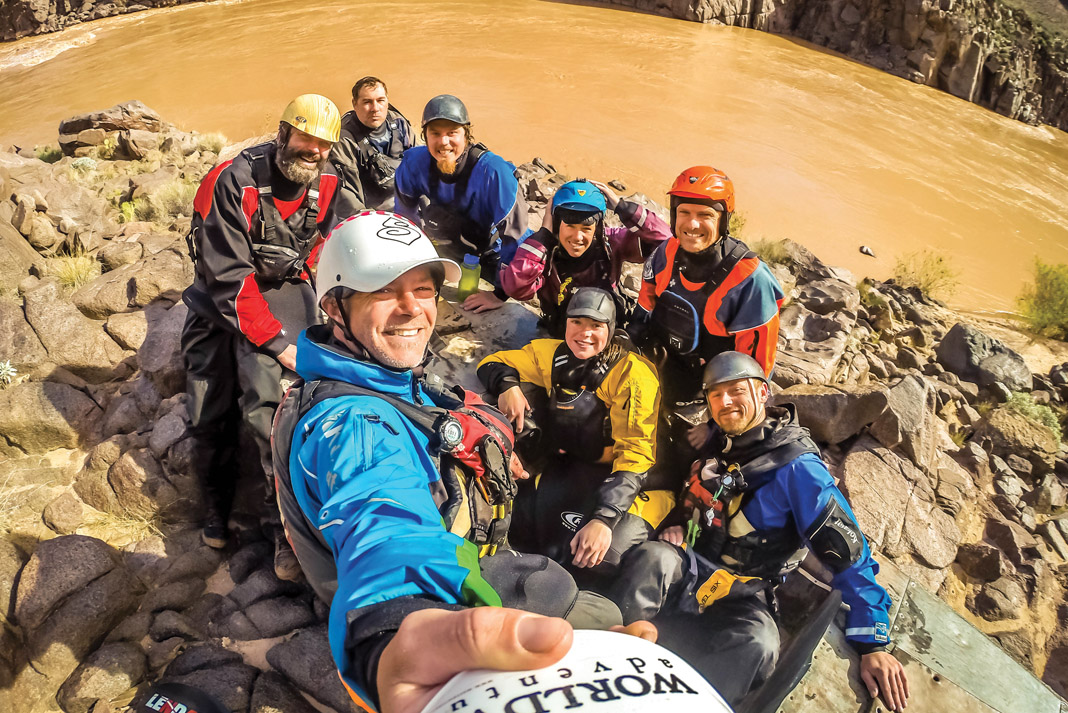
Ryan Fair, Kevin Maurer, Judd Spencer and our permit holder Heather Nichols are all paddling crossover river kayaks. Mike Gill and Danielle Cullen are in single sea kayaks, and last but not least is Neil Gibby, who crams 11 days of gear and food into a whitewater creek boat. We are a motley crew to say the least and an odd site to see on a rafting river. Every group we pass asks, “Are those sea kayaks?”
Our skill sets are also a mixed bag. Jillian has very little river experience. Neil has paddled the Milner Mile, a notorious class V considered the training ground for the Stikine River. Mike had a solid skill set though had never paddled a proper whitewater river before this. Danielle, who prefers Dan, had a solid roll and good skills, though limited experience in any rough water and nothing like kayaking the Grand Canyon in a composite sea kayak.
Setting off into a spectacular landscape
Energies are high at the put in as we shove our kayaks in the the current of the Colorado River marking the beginning of our 11-day, 364-kilometer endeavor.
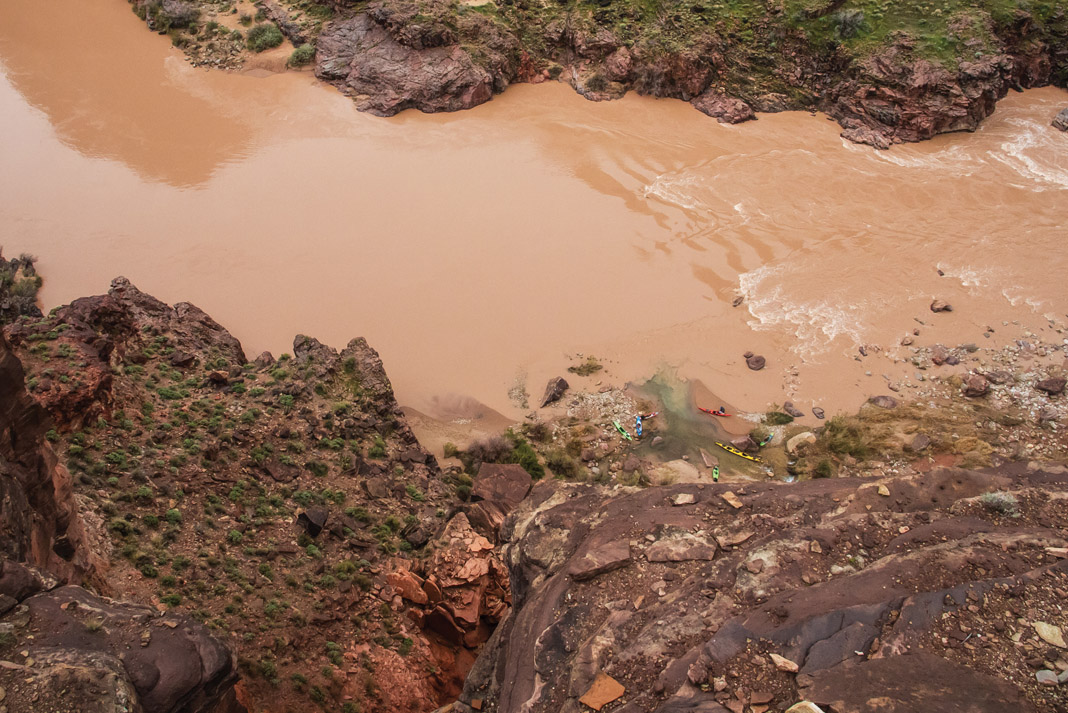
Once we round the first corner in the river, we are isolated, with only three ways out: hike up and walk out, float out, or fly out by helicopter rescue. The only reasonable hike is at a trailhead almost halfway down our intended journey.
As wonderfully remote as it is beautiful, the Grand Canyon appears a most suitable name for such a majestic geographic landmark. Seasonal rain congregates in side gulleys and canyons, rushing into the main river with silt, staining the river orange red, a trait that led to the river’s name. Colorado means the color red in Spanish. With red walls climbing to the sky and a red river running through it, almost always everything had an orange-red hue, emblazoned further by the setting or rising sun.
“The glories and the beauties of form, color and sound unite in the Grand Canyon–forms unrivalled even by the mountains, colors that vie with sunsets, and sounds that span the diapason from tempest to tinkling raindrop; from cataract to bubbling fountain,” wrote Powell.
Some calls are closer than others
The first couple of days through this majestic desert-scape are good training.
There are a couple swims and rescues, including our double. By the third day we find ourselves mere specks at the bottom of clay red cliffs looming thousands of feet above, threatening to choke out the sky.
February trips like ours are considered winter trips. We are allowed campfires. The days are not blisteringly hot. It is easier to get a permit in the winter.
Most trips down the canyon take about 18 to 21 days. Except with our chosen fleet of mostly smaller whitewater kayaks, we couldn’t carry that much food. Despite our shorter timeframe and more daily miles, we manage to end each day with plenty of light. In this “land that time forgot” we jump from waterfalls and sit amongst ancient ruins of people who once lived in the canyon and stored their foods high up in the cliffs above the seasonal flood levels of a once undammed river below.
Chocolate colored whitewater thunders around us as we drop into Unkar Rapid.
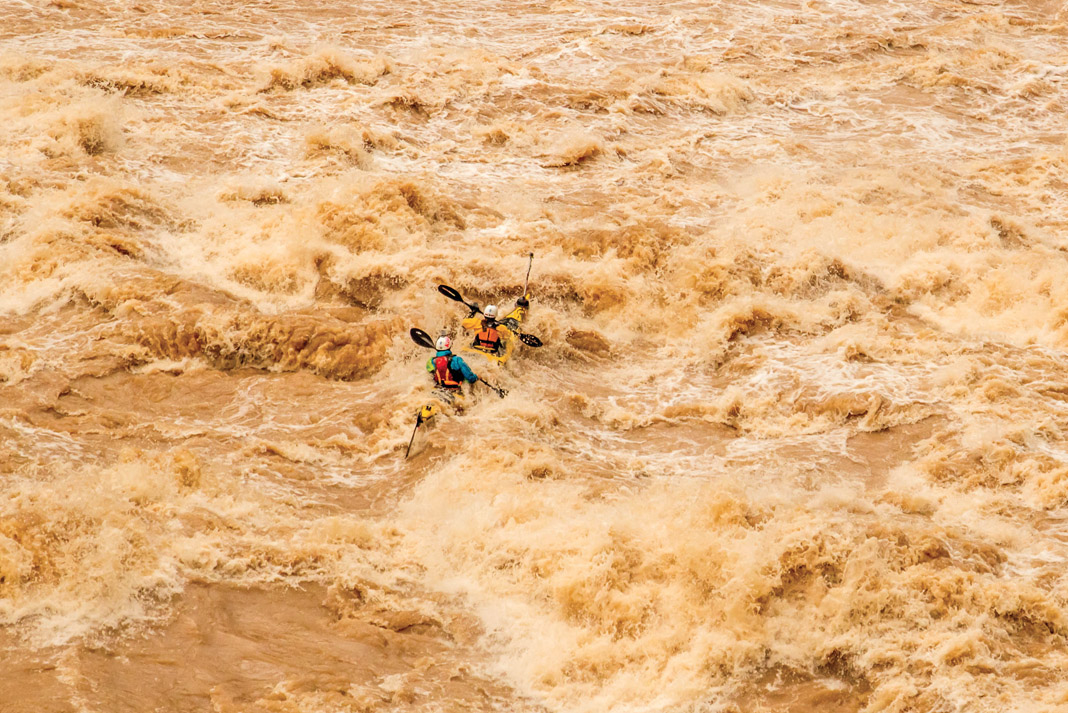
A large wave erupts to our right as I yell to Jill to paddle on the left, “Hard!” As our double kayak straightens up, Jill is plunged out of sight into a foaming pit of water, and then I disappear with her, into the silty darkness of an all-consuming valley and curtain of water. This is how it goes for us on the Colorado.
Through the rapid, we slip into the eddy to wait and watch for the rest of the team to come down. What we see is not good. Dan is swimming. But that isn’t the real the problem.
The real problem is her fiberglass kayak is running the rapid driven by unrelenting surging whitewater over and against the rocks, a place even a plastic boater doesn’t want her boat to be. I can hear in my mind the hollow thuds and brittle crunches of her kayak smashing on rocks.
We scramble to put Danny and the kayak back together at the bottom of the rapid.
The state of the kayak isn’t good. It had taken a couple of hits yesterday already, but this incident has it beaten raw. We look at frayed exposed fiberglass and large fractures in the gel coat. The dangers of kayaking the Grand Canyon in a composite kayak have literally hit home.
With the kayak patched with duct tape, we push on to camp.
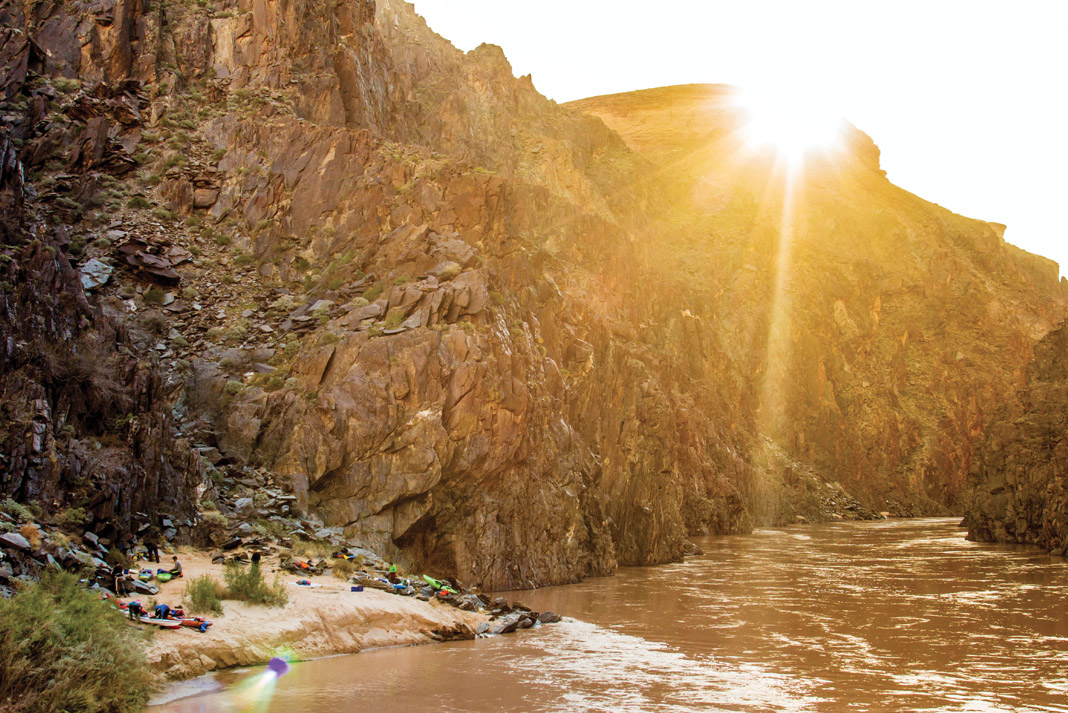
A parting of ways?
“I need to get out,” Dan states frankly at dinner. “I am in over my head and I am just destroying this kayak”.
“Let’s just sleep on it,” I tell her.
Around the fire we talk about ways to get Danny and what is left of her kayak out of the Canyon. We all agree knowing your limits and making smart decisions, even if it means backing down or adjusting your goals, is just a part of adventuring.
The next day we reached Phantom Ranch. This rustic lodge was set up in 1907 by David Rust to cater to prospectors, hunters and adventurous tourists who wanted to experience being in the Grand Canyon with some comfort.
As the only site in the Canyon developed for tourism, it provides relatively easy access for hikers and mule packers from rim to river. The only catch is that it is a six to nine hour hike straight up the canyon, and Dan has a kayak and gear. Even if she does get up there, how is she to get back to Flagstaff where our cars are parked?
There is no way a mule can carry a 16-foot kayak. We consider cutting her kayak completely in half. Or maybe three pieces will be better. And so goes the conversation.
Then we met Zach. Zach is a young scraggly hiker, a true-life character stepping out of a REI catalogue. He arrives sporting the quintessential mid-west stubbled face, trucker’s cap, shorts, flannel shirt, light hikers and a small backpack.
He has been hiking for three days off trail in the Grand Canyon and is just about to walk out to his car at the top of the trail and then drive home to Flagstaff. Perfect. A friendly, curious and adventurous guy, we all strike up an easy conversation. Jokingly, but not really, we throw out the idea of hiking out a sea kayak with Dan and driving her to Flagstaff.
“Sure, sounds like a good adventure,” replied Zach. “Though we need to leave soon.” Now two groups on separate adventures, we part ways below the bridge at Phantom Ranch.
Dan and her basic supplies along with Zach start hiking into the harsh, stark and steep canyon desert. She leaves three satchels of gear for mules to bring out the next day. If all goes well they’ll make it out before 10 p.m., climbing 5000 vertical feet over seven hours to the Grand Canyon’s south rim, three hours of that in the dark, all while carrying a touring kayak.
We wish Zach and Dan luck, certain that Dan’s fate will be better than the men who abandoned Powell. The rest of us have four of the biggest rapids on the canyon before camp. We float down the canyon as Dan’s tattered kayak floats up the canyon atop their shoulders.
Back to the task at hand
A few days later Jill and I have not flipped the double again and we’ve now run most of the bigger rapids.
Granite slammed us hard onto our side but I managed to roll back up with the help of the next wave. Jill is feeling pretty battered after days of being the first one to greet the waves of the Colorado. We still have the most notorious rapid on the trip, Lava Falls, and Neil’s been telling everyone, “It’s easy as long as you keep your line.”
There are apparently multiple options of travel through Lava, though for us there seems only one—moving from right to left right through the meat of the largest rapid on the Grand Canyon.
Despite what feels like hours scouting from above, getting to know our line, once on the water it all looks different. Bigger.
A huge foaming pit the size of a Silver Eagle tour bus is parked at the beginning of the rapid. This river feature flips fully-loaded whitewater rafts, breaks wooden oars like toothpicks and folds aluminum raft frames like tacos. Yet from the water we cannot see it until we are right above it and then we need to enter the rapid right next to it… and not into it.
With Neil’s simple speech ringing in my ears, I realize our line is slightly off. We need to be further right.
“Paddle,” I shout at Jill’s back. “PADDLE!”
Furious forward strokes from both of us and we slip past the thunderous hole, our blades grabbing the edge of the monster in unison while the rudder on the stern deck dips beneath the crashing water. We are sucked into the main flow and into waves coming together like the rotating blades inside a pencil sharpener. I struggle to find breaths amongst the exploding water, exertion of paddle strokes and shouting encouragement to “FORWARD PADDLE”.
I feel on the edge of control. I watch Jill disappear just as darkness engulfs us both like a heavy wet blanket. The water is so full of silt it is impenetrable by light.
Our entire kayak disappears underwater then erupts like a torpedo from a submarine.
We keep driving forward and toward the left side of the river. Eventually our slender double crosses the surging eddyline and turns back upstream.
“I think I was underwater for that whole thing,” Jill says grinning back over her shoulder. “Turns out it’s hard to be scared when you can’t see anything.”
A feeling of accomplishment
We travel a few more day of rapids, though now with Lava behind us the energy of the group has shifted. Our spirits are high, relaxed. We spread out more and enjoy time alone floating toward our agreed upon camping areas.
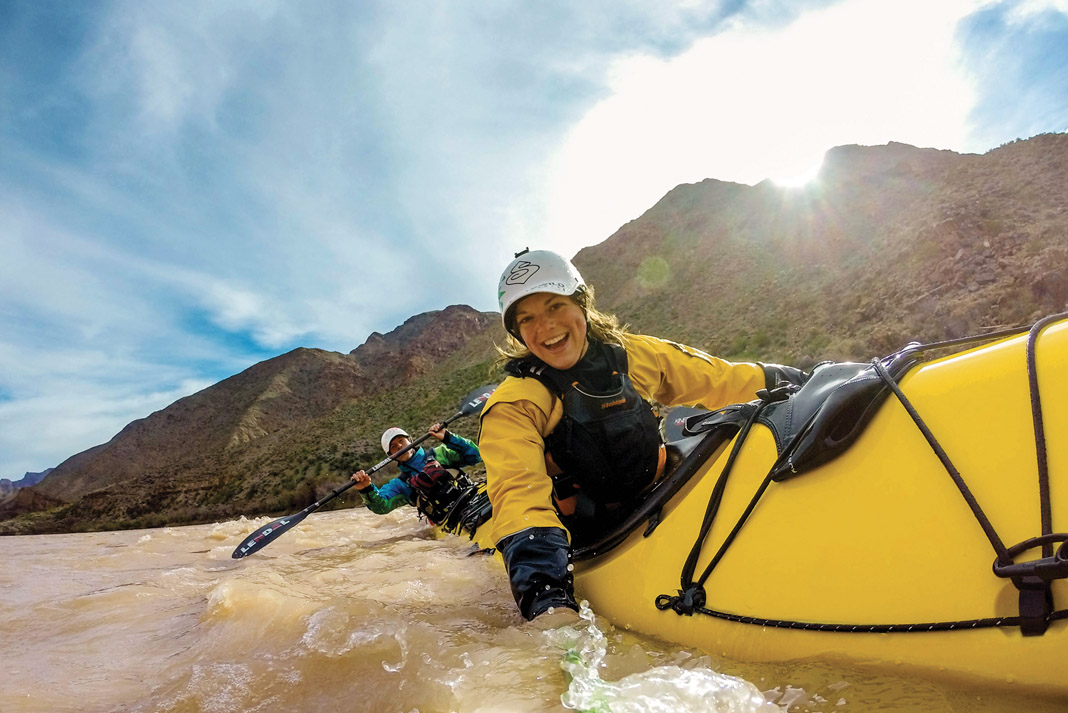
On the last day we float to the take out to find Dan sitting with our shuttle driver, vehicle and trailer. We have tasted a little of what John Wesley Powell experienced in his wooden dories some 150 years earlier. Dan is holding a box of donuts with a big grin on her face and her own great story to tell. After all, she played a key role in the first expedition to hike out of the Grand Canyon with a sea kayak.


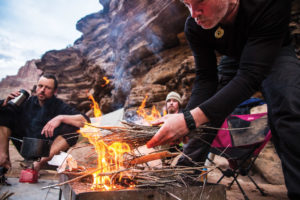
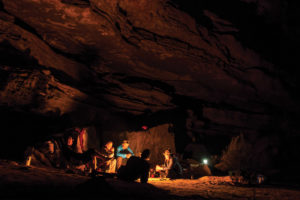
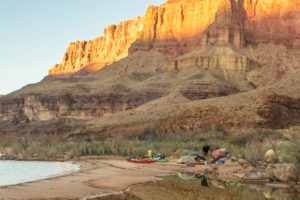
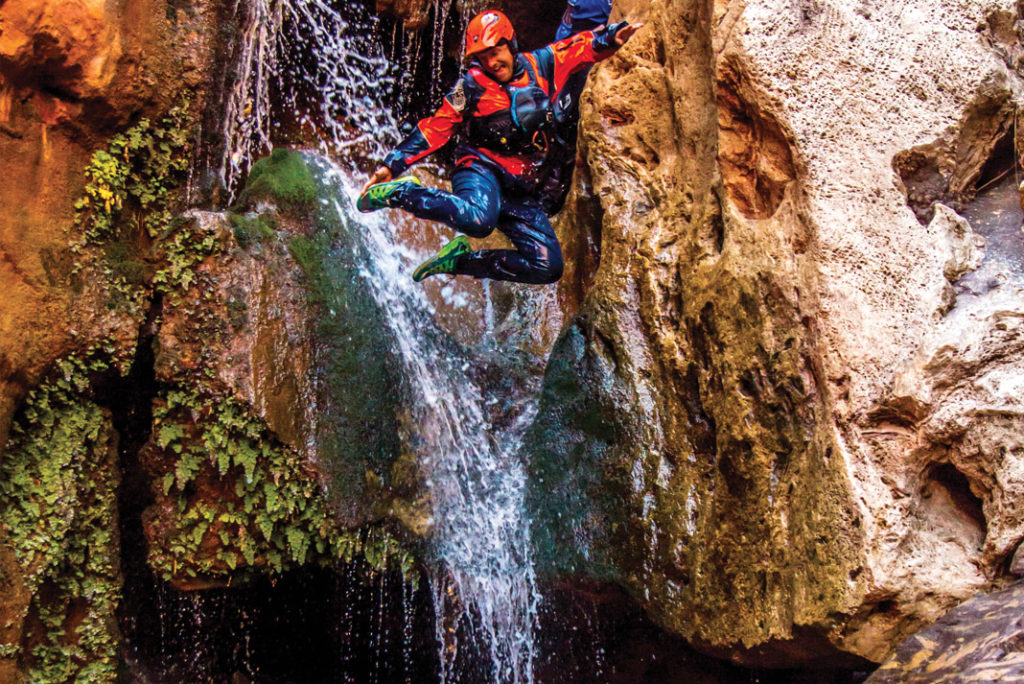
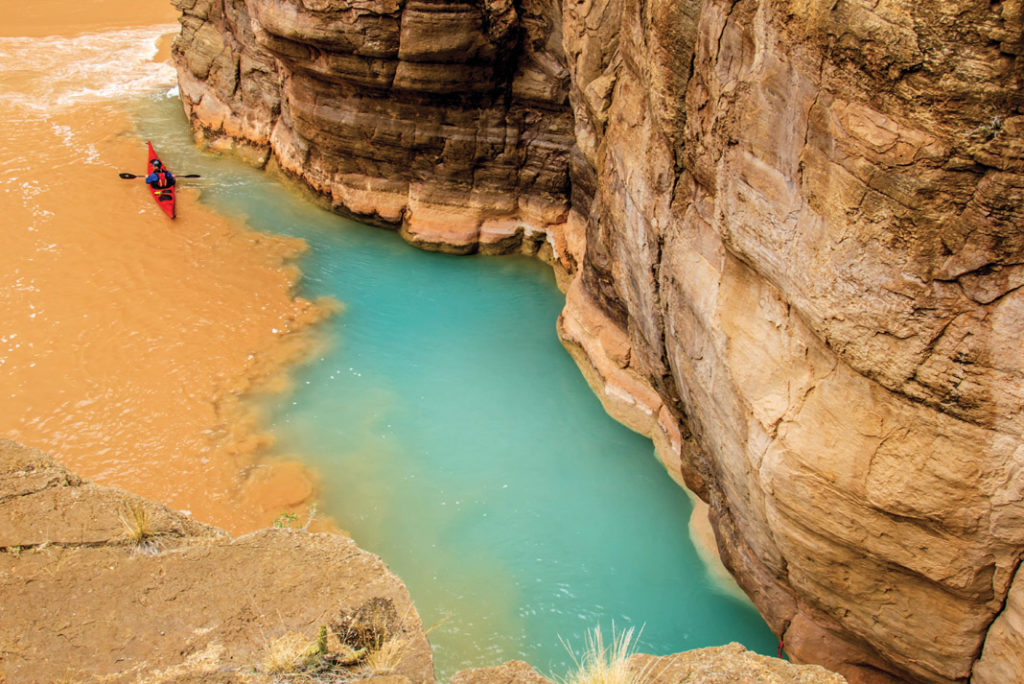
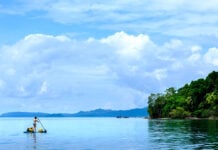
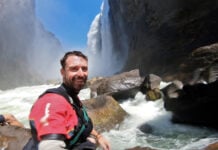
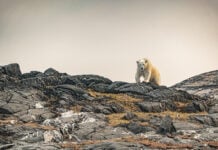
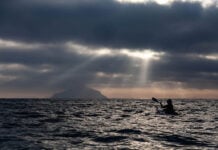
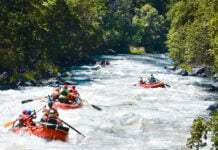

Nice writing, I was mesmerized!!!! I just met Jillian this morning, she is a nice person!!! I felt like I was in the river with you while I was reading this!!! 🙂
Great story!!
Fun run. I paddled in a low volume fiberglass World Cup C-2 racing boat down the Grand in 1984. I agree, it did add an extra level of uncertainty. But it was a lot of fun! Your article reminded me of the trip. Great times.